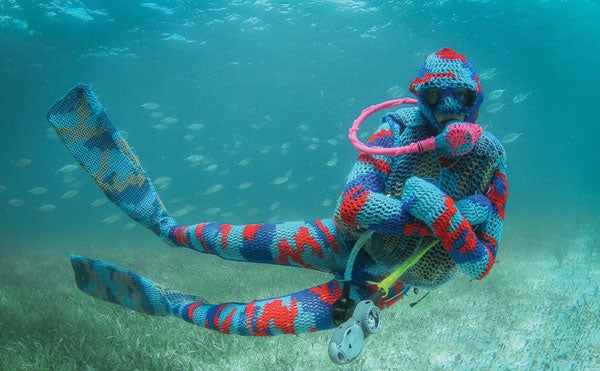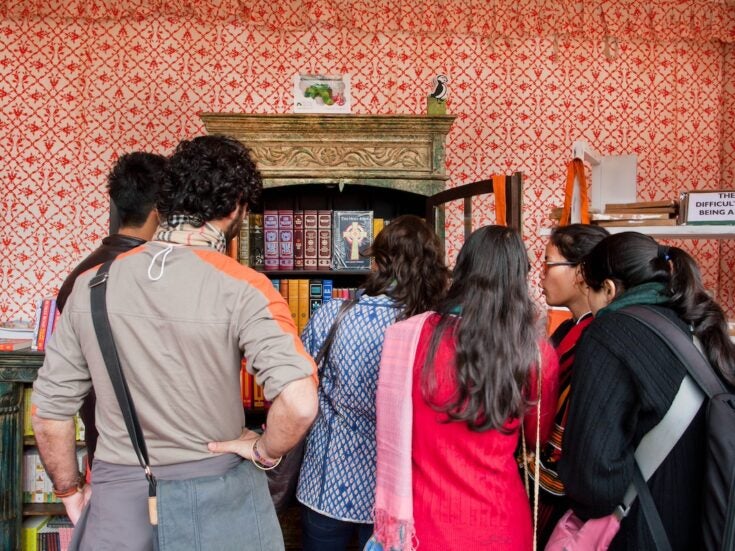

It was a few years back that I saw the first piece. It was a bicycle, fully crocheted in coloured wools, and it was leaning against a bin in Chelsea, still then the main Manhattan art district. The bike looked at once real and startling, an intruder from fantasy. It didn’t look to me like Outsider art, more the work of a pro.
Correct. It was by Olek.
Olek was born Agata Oleksiak in Poland in 1978.
So: how did it all begin?
‘The journey? The unending journey?’ says Olek.
Yes. That.
‘When I was a little girl, there was nothing in the department stores. As a kid I learned to crochet a little. It was something to do when I was growing up; we had to reinvent what we had, to make something out of it. I spent a whole week collecting the tin caps from the milk we got every day to make art. I would collect the shiny paper when we had chocolate and make something out of it. I really hate it when artists say, “I can’t work because I don’t have materials.” Find your own materials! Find your own!’
When she got bigger?
‘It was impossible to purchase any nice clothes. Or clothes at all. But it was very easy to find a seamstress. I had the most amazing wardrobe, but it was so different that I started to be treated as an outcast.’
Olek resolved to move to New York. ‘I couldn’t wait to get out,’ she says. ‘It wasn’t my dream to be an artist. My dream was to have a different life. In Poland I wouldn’t have the chance to have my own life. By moving here I could write my own life, the story that I want to have.’
She got to New York in 2000. She was 22.
‘I had the worst jobs ever,’ she says. ‘I was cleaning houses, I had so many different jobs. And I was making costumes. I had to go to school for a visa so I went to La Guardia Community College, and an instructor there, Michael Rodriguez, gave me my first show. It was a big challenge because I had never made sculptures out of fabric. I stopped by a 99-cent store and bought some materials, blanket cloth, anything. At home I was trying to figure out the best way to make something out of it, I thought of
gluing things together, of braiding. And then I thought, “How about crochet?” And that was how this story started.’

How did the idea develop?
‘I started when everyone was in school. I crocheted the swimming pool. When I started I had never done anything in art before — it wasn’t like I was doing other things and started crocheting. I started making art in crocheting right away. It was like I was trying to avoid being an artist all my life, and then I came to the United States and it hit me in the face. You can’t avoid it any more! You’re going to have to be working as an artist. And I immediately started making these things.’
That explains the crochet. But she could have been making work for shows in galleries, or working with collectors and museums. Why take to the streets?
‘In galleries it’s, “I want this wall… I want this wall…” I remember I did this project during the Istanbul Biennial in 2005 — there were artists wanting an installation in a gallery and they were fighting about the walls. And I go, “Fuck this! I’m not going to fight over the walls. Take all the walls!”‘
She spoke to the gallerist. ‘I said how there was no space inside so I am going to present something outside.’ What did she present outside? ‘I crocheted the gallerist’s car.’ Uh, OK! Crochet is not for wimps is clearly the message here.’I think artists that work in public spaces connect together quite well,’ she says. ‘Very well. In opposition to artists who only work in the galleries. Simply because there are endless opportunities in our space for us to do something — we don’t have to fight, we support each other.’
So Olek was a street artist now. And she acquired some fans in that community. ‘The biggest supporter of my work was Futura 2000,’ she says. ‘He was the first person who wrote me an email when I started working. I said, “Who is this guy? Futura 2000? Who is sending me all the emails almost every day with pictures of my work?” They said, “You don’t know who he is?”‘
She looked into it. Futura 2000 was huge in the first graffiti generation. ‘And then I was like, “Oh my God! It’s amazing that this guy would recognise me.” He actually commissioned me to make a sculpture. He gave me a painting. He’s an amazing guy, an amazing friend, and he’s a really big supporter of the younger artists, the younger generation. He smokes Camels with no filters and he always gives me a pack of Camels, and I smoke one cigarette before doing a public work somewhere. That’s my tradition. And he has to bring me the pack again.’
How does Olek decide what to crochet? ‘In 2002, I crocheted between trees because they were around me. I covered a stepladder because my ex-girlfriend had one and I was bored when she was working. Everything comes from feelings and intuition. The public may not know the background story. They accept it or even love it because it is honest — I hope.’
What was the most unusual thing she ever crocheted? ‘Once it is done it is not unusual any more. I would say the next one! In 2009 I had a residency in Lower East Side Studios. I went to the Essex Market and bought different fruits and vegetables. And I went to my studio and I was crocheting them and I watching a movie, La Grande Bouffe. I was watching the movie over again because I was making a connection between the movie and the crochet I was doing, so I watched it over and over again as I crocheted these fruits and vegetables. And then I took them back to the Essex Market and I put them in the same places. And later somebody collects all of them and puts them in a basket.

‘So I crochet a lot of stuff. Crochet for me is a language — it’s the way I illustrate the thoughts that I’ve got in my head. I have shapes and colours. It’s like painting something — painting a space, painting an environment.’
Does it matter that people recognise what it is that she has crocheted — hey, that’s a car or a tree — or does she sometimes like to make mysterious objects?
‘No. They are very direct, self-explanatory. If it’s a chair, it’s a chair; if it’s a house, it’s a house.’ So what is the reality? The thing you crochet? ‘I am creating my own reality. The world is too boring; I have to remake it.’ So how can Olek make a living? If she crochets a car she can’t sell it, right?
‘I do commissions,’ she says. ‘And I sell works in the galleries when I have a show.’
Olek and her support team have crocheted some huge projects, including the side of a building and a train. Are there things she’d like to do that she hasn’t done yet?
‘Of course. I have a list of them. I’d like to crochet a glider, and I was going to do a plane once but the project was cancelled. I’d love to crochet a plane.’
Has she ever crocheted living things? ‘People! I have crocheted people. You’ve never seen my people, all crocheted?’ As a kind of proof, she hands me a crocheted body part. No, I won’t say which, only that I promised I would wear it as if it were my own.







